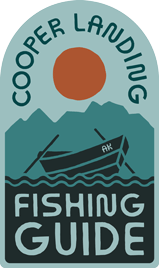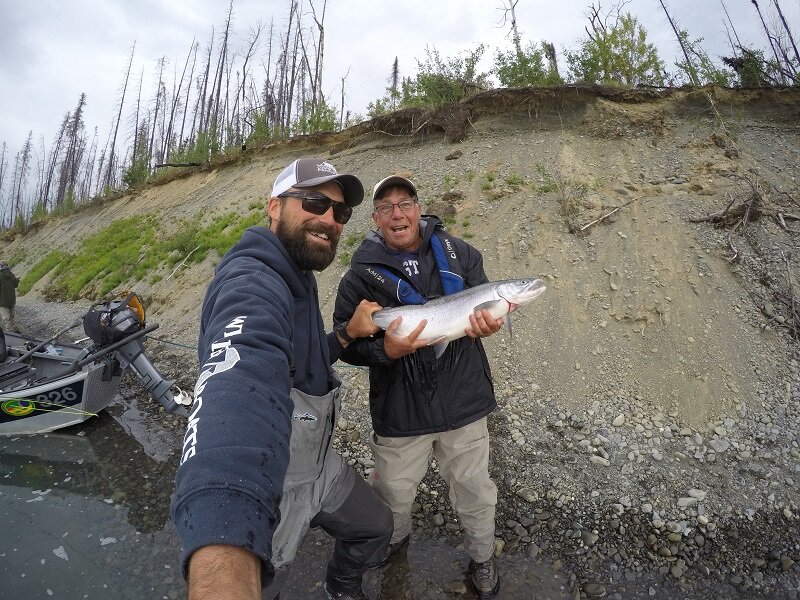KENAI RIVER SOCKEYE SALMON
JUNE 11th - AUGUST 10th
Sockeye Salmon get their name from the native Salish language. Sockeye means “red salmon.” The color of their flesh and red bodies when spawning give them the namesake. Sockeye Salmon are excellent to eat and are in the top 2 or 3 best tasting salmon. The average 6-10 lbs in size and are very powerful, especially in the Kenai River.
Every year, upwards of 1 million or more Sockeye Salmon migrate towards the Kenai River.. The abundance of red salmon returning to the Kenai is welcomed every year. They are very important to the ecosystem. Sockeye feed anglers, bears, seals and more. They also feed hungry rainbow trout and dolly varden, plus young trout and salmon as well.
The migration run of Sockeye a great time of year to fish. But when they spawn, the “bead bite” ensues. This makes fly fishing for trout outstanding! Runs in May, June and July and a run in late June and July on the Kasilof River keep anglers busy for hundreds of river miles.
IMPORTANCE OF SOCKEYE SALMON TO THE KENAI RIVER
Sockeye Salmon are the hardest fighting Salmon in Alaska. They are also the most prized salmon for anglers. Sockeye or "Red" salmon will put the most skilled anglers and the best rods & reels to the ultimate test.
Sockeye have an endless supply of energy. They are known for their blistering speed, aerial displays and rod-bending power. Every year, they break at least one of our rods and we usually have to replace at least 1 or 2 reels.
Averaging between 4-6 lbs., Sockeye return to the Kenai River in huge numbers. During typical summers, upwards of 1.5 million fish make their annual spawning run. Two distinct runs come up the Kenai River. The first run starts when the upper Kenai River opens on June 11th. 40,000 fish or more make their way up the Kenai to the Russian River, a mountain tributary in Cooper Landing. This run lasts through early July.
The second, more prolific run of Sockeye Salmon arrives in mid-July. Daily numbers of Sockeye entering the Kenai can reach upwards of 50,000 fish! The fish spread out along the length of the Kenai. This generally spreads out angling pressure.
Most successful fishing for Sockeye Salmon happens between June 11th and August 10th. This is when fresh fish are still entering the system. The key to angling success and a full freezer is the proper gear, technique and expectations.
Sockeye Salmon primarily feed on plankton while in the ocean. Other Salmon feed on fish, crustaceans, squid and other prey. This means it can be difficult to entice them to take spinners and flies that Coho and Kings are known to take.
HOW TO FISH FOR SOCKEYE SALMON
The primary technique to hook a Sockeye is known as "flipping." Anglers "flip" a weight, leader and fly a short distance from the shore. A long leader and "Russian River Fly" or "Coho Fly" is cast across the current. The weight is slid along the bottom through migrating fish. Most Sockeye will successfully hook themselves as they swim up river in the corner of their mouths. This is when the fun really begins!
Sockeye are explosive and can literally rip the rod out of your hands if you're not careful. The absolute key to landing a fish is to keep your rod tip low and downstream. Most fish are hooked on the outside of their mouths away from you. If you lift your rod or bring it upstream, there's a very good chance you'll lose your fish.
Be prepared for multiple, full-speed, powerful runs. The lower your rod angle, the more you'll be able to control the fish. You will not be able to tire Sockeye out. You either have to have a good net person or drag the fish to the shore (that is if you plan on harvesting your fish). If you do not plan on harvesting Sockeye, do not beach them. Their survival rate will suffer.
SUGGESTED EQUIPMENT:
8 OR 9 WT FLY ROD
LARGE ARBOR FLY REEL WITH PLENTY OF BACKING AND POWERFUL DRAG SYSTEM
30 LB. LEADER
SNAP SWIVEL
BELL SINKERS (VARIOUS WEIGHTS)
25 LB. TIPPET
STRONG SALMON HOOK SIZE 2 OR 4 (CHECK REGULATIONS)


